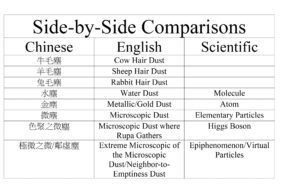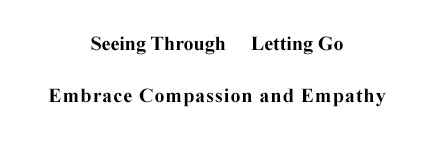Having verified Citta, we verify the remaining doctrines in Such is the Way of Dharma. These include non-luminosity, adventitiousness, and two realms of separate reality. Unlike Citta, which must be verified through enlightened people, the remaining doctrines can be verified using science. However, some relevant scientific concepts must first be introduced before doing so.
Buddha’s non-luminosity can be considered the equivalent to the quantum realm in science. They are both realms of fluctuating waves, although they differ in what fluctuates. In science, the waves are quantum energy, while in Buddhism, it is mentality, or consciousness, since consciousness is mentality fluctuating. The significance is that Buddhism and science intersect fundamentally in this realm because they both consider fluctuating waves as the building blocks of the universe. Furthermore, while the fact that they intersect is important, where they intersect is critical. This post discusses how they intersect precisely on the tiniest particle possible, the ripples in the fluctuating fields.
The discussion on ripples involves particles in quantum mechanics and the Standard Model of Particle Physics, or simply the Standard Model, and their corresponding “dust” in Buddhism. In the context of our discussion, “dust (Chinese=塵)” is the Buddhist equivalent of particles in science.
Two Buddhist sutras mention the dust relevant to our current discussion.
The first one is The Abhidharmakośakārikā (Chinese=阿毗達磨俱舍論) or Verses on the Treasury of Abhidharma. It “is a key text on the Abhidharma written in Sanskrit verse.” Abhidharma (Sanskrit; Chinese=阿毗達磨) “are ancient (3rd century BCE and later) Buddhist texts which contain detailed scholastic presentations of doctrinal material appearing in the Buddhist sutras.”
According to this article, the Abhidharmakośakārikā mentions twelve dust, starting with the coarse “finger knuckle dust” and ending with the “extreme microscopic of microscopic dust.” Seven dusts are selected for use in the side-by-side comparison table below. They are chosen either because they are useful for explaining the logic of how Buddha arranges his dusts or for comparison with their corresponding scientific particles. The unselected ones do not serve either of these functions.

The two columns on the left side of the table list Buddha’s dusts in Chinese and their English translation. On the right side are the corresponding particles from the Standard Model, plus epiphenomenon, a term used in quantum mechanics for the smallest particle in the universe.
1)The three dusts on top of the list are cow hair dust (Chinese=牛毛塵), sheep hair dust (Chinese=羊毛塵), and rabbit hair dust (Chinese=兔毛塵).
They are too coarse to have their corresponding particles in the Standard Model. They are listed to help explain the logic of the Buddhist arrangement of dusts.
Imagine cutting the cow, sheep, and rabbit hair dusts in cross-sections. The area of the cross-section of the cow hair is larger than the area of the cross-section of the sheep hair and, therefore, can accommodate larger dust. The same holds for moving from sheep to rabbit hair dust. In other words, Buddhist dust is arranged in descending order by size/complexity.
2) The next one from Buddha is water dust (Chinese=水塵), and water corresponds to a molecule in the Standard Model.
A Molecule “is a group of two or more atoms held together by attractive forces known as chemical bonds.” Therefore, molecules belong to a higher category than atoms.
3) The next one after water is the gold dust (Chinese=金塵). However, the Chinese character 金 can stand for gold or any metallic particles in the Periodic Table. In the Standard Model, gold or a metallic particle belongs to the atomic group.
An atom “is a particle that consists of a nucleus of protons and neutrons surrounded by a cloud of electrons.”
4) The next smaller one after gold in Buddha’s list is the “microscopic dust” group (Chinese=微塵) and corresponds to the Elementary Particles group in the Standard Model.
An Elementary Particle (or fundamental particle) is the smallest particle in the Standard Model. It “is a subatomic particle that is not composed of other particles.” Examples of commonly known subatomic particles include electrons, protons, and neutrons.
5) Within Buddha’s “microscopic dust group,” there is a dust called “microscopic-dust-where-rupa-gathers.” As discussed earlier, rupa is “body, form, and materiality.” So, it is significant dust because this is the first time a dust appears with materiality in the universe. Known by another name in the Twelvefold Chain of Dependent Origination, which is Buddha’s teaching on how the phenomena in the universe are conditionally originated, the “microscopic-dust-where-rupa-gathers” is important because Buddha’s universe cannot be built without it.
The Standard Model has a particle called the Higgs Boson, which is an elementary particle occupying a unique position among the seventeen elementary particles.
Higgs Boson is a Nobel Prize-winning discovery named after its proponent, Dr. Peter Higgs. Higgs Boson is critically important in physics because it is the first particle to have mass. A particle with mass is essential in physics because constructing the universe is impossible without a particle having mass. For this reason, the Higgs Boson is often referred to as the “God particle.”
Therefore, the “microscopic-dust-where-rupa-gathers” and Higgs Boson are essential in building their respective universes. They can be considered equivalent because mass and materiality can be regarded as equivalent. However, with their construction materials, a universe built from “microscopic-dust-where-rupa-gathers” is significantly different than a universe built from energy. While consciousness is nowhere to be found in the scientific universe built from quantum energy, Buddha’s universe built from mentality is one where all are conscious.
6) In Buddhism, the next smaller dust than the “microscopic-dust” is the “extremely-microscopic-of-the-microscopic dust (Chinese=極微之微塵).” However, Buddha gives this dust another name in Śūraṅgama Sūtra, the second sutra mentioned earlier.
Śūraṅgama Sūtra (Chinese=首楞嚴經) “is a Mahayana Buddhist sutra that has been especially influential on Korean Buddhism (where it remains a major subject of study in Sŏn monasteries) and Chinese Buddhism (where it was a regular part of daily liturgy during the Song). It was particularly important for Zen/Chan Buddhism. The doctrinal outlook of the Śūraṅgama Sūtra is that of Buddha-nature, Yogacara thought, and esoteric Buddhism.”
In Śūraṅgama Sūtra, the “extremely-microscopic-of-the-microscopic dust” is also called “neighbor-to-Emptiness dust” (Chinese=鄰虛塵).” Furthermore, it comments, “If the “neighbor-to-Emptiness dust” is analyzed further, it would be actual Emptiness (Chinese = 更析鄰虛,即實空性).” Here, Emptiness denotes the Emptiness of Citta.
As a “neighbor” to “Emptiness,” it suggests that the “neighbor-to-Emptiness dust” and “Emptiness” are close. The comment “If the “neighbor-to-Emptiness dust” is analyzed further, it would be actual Emptiness” suggests that the “dust” and “Emptiness” are essentially the same but may differ in form.
Given that nothing exists in “Emptiness” except the mentality that can never change, we can surmise that what separates Emptiness from “neighbor-to-Emptiness dust” is their fluctuating status, which also puts them in two different realms: one in the Ultimate Reality and the other in non-luminosity. With “neighbor-to-Emptiness dust” existing in a sea of fluctuating non-luminosity, ripples are the only entity that can be a “neighbor” to Emptiness, but not quite the same. Therefore, we can surmise that “neighbor-to-Emptiness dust” is a ripple in non-luminosity.
In this Closer to Truth episode, Nobel Laureate Dr. Frank Wilczek said, “The most basic objects out of which to construct the universe are not particles but objects we call quantum fields. We think of them as space-filling ethers that create and destroy the objects, the particles. …….. We see particles as epiphenomena. They are kind of ripples on the deep structure.”
While this may have been only a simple statement of fact from Dr. Wiczek, it is monumental in understanding Buddhism. By linking ripples in the quantum field to epiphenomena, Dr. provides the link between ripples in non-luminosity and “neighbor-to-Emptiness dust.”
It is monumental because, in his doctrine known as Three Delicate Marks, Buddha teaches that many fundamental phenomena originated in non-luminosity inseparably on “something” without mentioning what that “something” is. Of course, one can surmise that the only things in a field of fluctuating mentality are ripples. However, that does not help much either. Given that ripples are not mentioned in Buddhist sutras, without associating them with a known “dust,” it does not help much to understand the Three Delicate Marks doctrine.
By associating the ripples in non-luminosity and “neighbor-to-Emptiness dust,” Dr. Wiczek makes it understandable that the myriad fundamental phenomena in Buddhism originated on a “neighbor-to-Emptiness dust.” Additionally, having Buddhism and quantum mechanics intersect precisely at the tiniest particle/dust possible at the foundation of the universe makes Buddism essentially a mental version of quantum mechanics in nature, where waves of mentality replace quantum energy waves. Indeed, to some, Buddhism is just as “mind-bogglingly weird” as quantum mechanics.
It is true because it may already be mind-boggling to some that Buddha could discover everything discussed in this post thousands of years ago alone without help.
This puzzle will be solved when we discuss epistemology.


